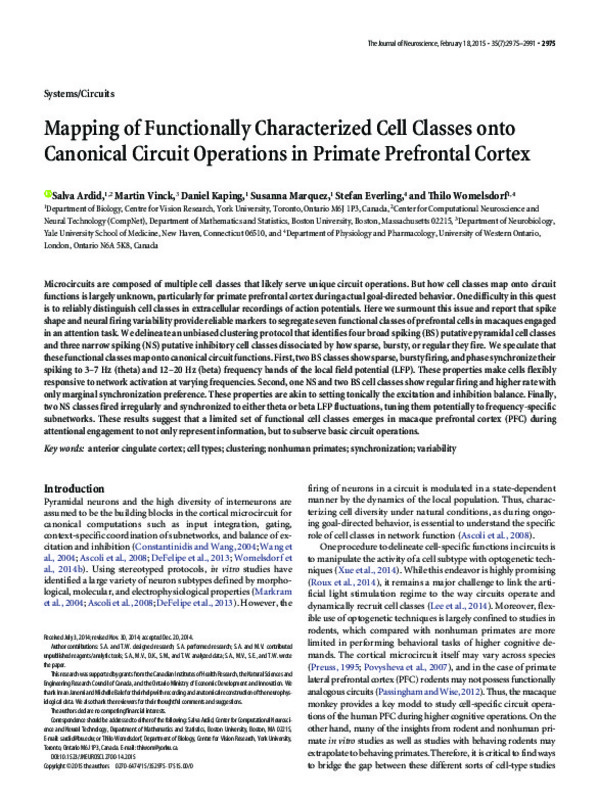JavaScript is disabled for your browser. Some features of this site may not work without it.
Buscar en RiuNet
Listar
Mi cuenta
Estadísticas
Ayuda RiuNet
Admin. UPV
Mapping of functionally characterized cell classes onto canonical circuit operations in primate prefrontal cortex
Mostrar el registro sencillo del ítem
Ficheros en el ítem
| dc.contributor.author | Ardid-Ramírez, Joan Salvador
|
es_ES |
| dc.contributor.author | Vinck, M.
|
es_ES |
| dc.contributor.author | Kaping, D.
|
es_ES |
| dc.contributor.author | Marquez, S.
|
es_ES |
| dc.contributor.author | Everling, S.
|
es_ES |
| dc.contributor.author | Womelsdorf, T.
|
es_ES |
| dc.date.accessioned | 2021-06-01T03:32:13Z | |
| dc.date.available | 2021-06-01T03:32:13Z | |
| dc.date.issued | 2015-02-18 | es_ES |
| dc.identifier.issn | 0270-6474 | es_ES |
| dc.identifier.uri | http://hdl.handle.net/10251/167006 | |
| dc.description.abstract | [EN] Microcircuits are composed of multiple cell classes that likely serve unique circuit operations. But how cell classes map onto circuit functions is largely unknown, particularly for primate prefrontal cortex during actual goal-directed behavior. One difficulty in this quest is to reliably distinguish cell classes in extracellular recordings of action potentials. Here we surmount this issue and report that spike shape and neural firing variability provide reliable markers to segregate seven functional classes of prefrontal cells in macaques engaged in an attention task. We delineate an unbiased clustering protocol that identifies four broad spiking (BS) putative pyramidal cell classes and three narrow spiking (NS) putative inhibitory cell classes dissociated by how sparse, bursty, or regular they fire. We speculate that these functional classes map onto canonical circuit functions. First, two BS classes show sparse, bursty firing, and phase synchronize their spiking to 3-7 Hz (theta) and 12-20 Hz (beta) frequency bands of the local field potential (LFP). These properties make cells flexibly responsive to network activation at varying frequencies. Second, one NS and two BS cell classes show regular firing and higher rate with only marginal synchronization preference. These properties are akin to setting tonically the excitation and inhibition balance. Finally, two NS classes fired irregularly and synchronized to either theta or beta LFP fluctuations, tuning them potentially to frequency-specific subnetworks. These results suggest that a limited set of functional cell classes emerges in macaque prefrontal cortex (PFC) during attentional engagement to not only represent information, but to subserve basic circuit operations. | es_ES |
| dc.description.sponsorship | This research was supported by grants from the Canadian Institutes of Health Research, the Natural Sciences and Engineering Research Council of Canada, and the Ontario Ministry of Economic Development and Innovation. We thank Iman Janemi and Michelle Bale for their help with recording and anatomical reconstruction of the neurophysiological data. We also thank the reviewers for their thoughtful comments and suggestions. | es_ES |
| dc.language | Inglés | es_ES |
| dc.publisher | Society for Neuroscience | es_ES |
| dc.relation.ispartof | Journal of Neuroscience | es_ES |
| dc.rights | Reconocimiento (by) | es_ES |
| dc.subject | Anterior cingulate cortex | es_ES |
| dc.subject | Cell types | es_ES |
| dc.subject | Clustering | es_ES |
| dc.subject | Nonhuman primates | es_ES |
| dc.subject | Synchronization | es_ES |
| dc.subject | Variability | es_ES |
| dc.subject.classification | FISICA APLICADA | es_ES |
| dc.title | Mapping of functionally characterized cell classes onto canonical circuit operations in primate prefrontal cortex | es_ES |
| dc.type | Artículo | es_ES |
| dc.identifier.doi | 10.1523/JNEUROSCI.2700-14.2015 | es_ES |
| dc.rights.accessRights | Abierto | es_ES |
| dc.contributor.affiliation | Universitat Politècnica de València. Instituto de Investigación para la Gestión Integral de Zonas Costeras - Institut d'Investigació per a la Gestió Integral de Zones Costaneres | es_ES |
| dc.description.bibliographicCitation | Ardid-Ramírez, JS.; Vinck, M.; Kaping, D.; Marquez, S.; Everling, S.; Womelsdorf, T. (2015). Mapping of functionally characterized cell classes onto canonical circuit operations in primate prefrontal cortex. Journal of Neuroscience. 35(7):2975-2991. https://doi.org/10.1523/JNEUROSCI.2700-14.2015 | es_ES |
| dc.description.accrualMethod | S | es_ES |
| dc.relation.publisherversion | https://doi.org/10.1523/JNEUROSCI.2700-14.2015 | es_ES |
| dc.description.upvformatpinicio | 2975 | es_ES |
| dc.description.upvformatpfin | 2991 | es_ES |
| dc.type.version | info:eu-repo/semantics/publishedVersion | es_ES |
| dc.description.volume | 35 | es_ES |
| dc.description.issue | 7 | es_ES |
| dc.identifier.pmid | 25698735 | es_ES |
| dc.identifier.pmcid | PMC6605590 | es_ES |
| dc.relation.pasarela | S\434987 | es_ES |
| dc.contributor.funder | Canadian Institutes of Health Research | es_ES |
| dc.contributor.funder | Ontario Ministry of Economic Development and Innovation | es_ES |
| dc.contributor.funder | Natural Sciences and Engineering Research Council of Canada | es_ES |








